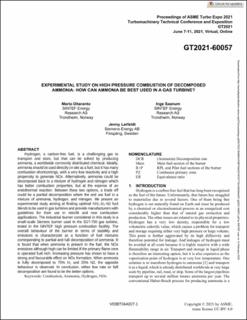| dc.description.abstract | Hydrogen, a carbon-free fuel, is a challenging gas to transport and store, but that can be solved by producing ammonia, a worldwide commonly distributed chemical. Ideally, ammonia should be used directly on site as a fuel, but it has many combustion shortcomings, with a very low reactivity and a high propensity to generate NOx. Alternatively, ammonia could be decomposed back to a mixture of hydrogen and nitrogen which has better combustion properties, but at the expense of an endothermal reaction. Between these two options, a trade off could be a partial decomposition where the end use fuel is a mixture of ammonia, hydrogen, and nitrogen. We present an experimental study aiming at finding optimal NH3-H2-N2 fuel blends to be used in gas turbines and provide manufacturers with guidelines for their use in retrofit and new combustion applications. The industrial burner considered in this study is a small-scale Siemens burner used in the SGT-750 gas turbine, tested in the SINTEF high pressure combustion facility. The overall behaviour of the burner in terms of stability and emissions is characterized as a function of fuel mixtures corresponding to partial and full decomposition of ammonia. It is found that when ammonia is present in the fuel, the NOx emissions although high can be limited if the primary flame zone is operated fuel rich. Increasing pressure has shown to have a strong and favourable effect on NOx formation. When ammonia is fully decomposed to 75% H2 and 25% N2, the opposite behaviour is observed. In conclusion, either low rate or full decomposition are found to be the better options. Copyright © 2021 by ASME. | en_US |
